Yes, You Can Grow Wine Grapes in Montana!
Here's how I'm doing it...
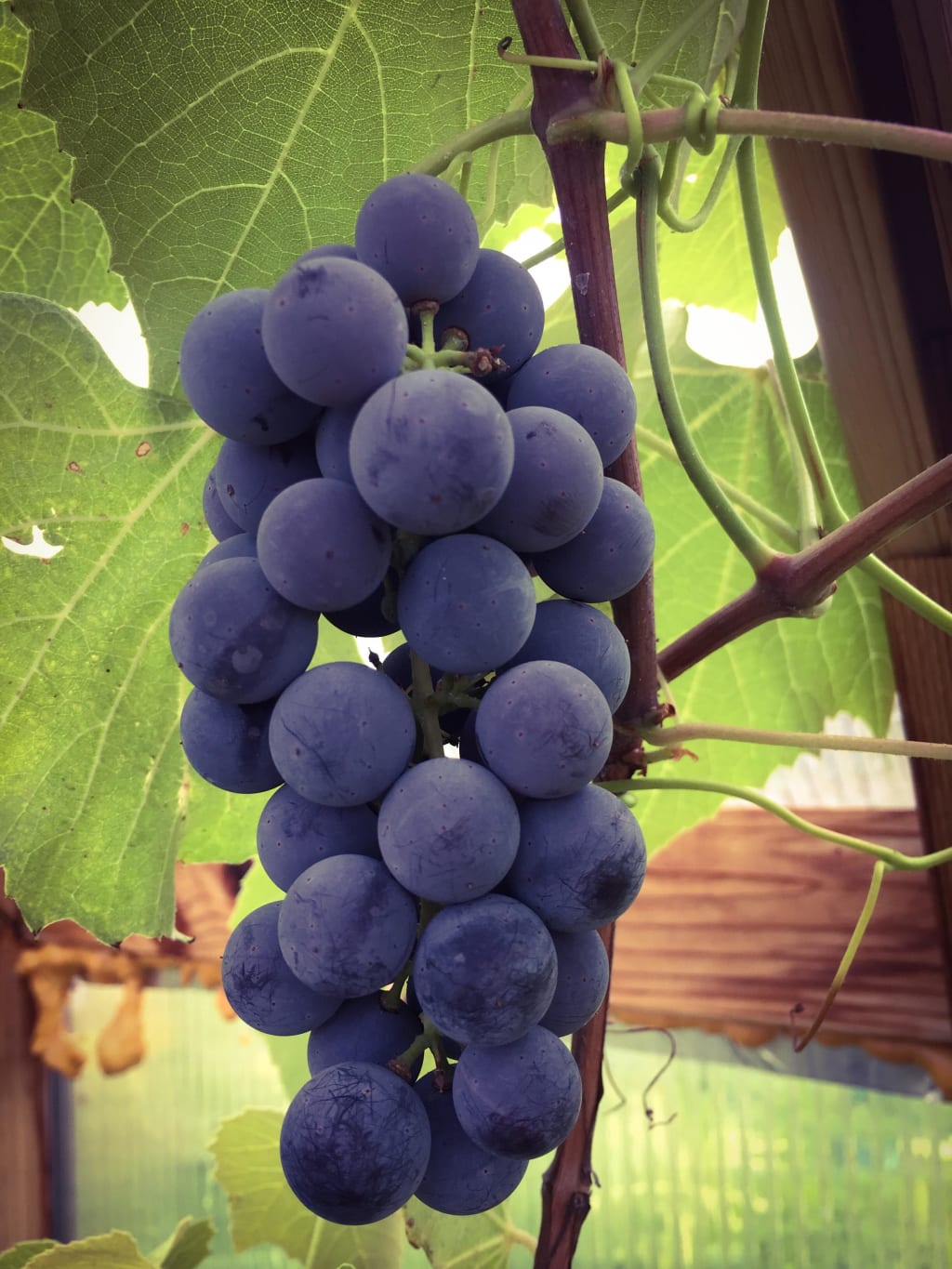
It began with a simple trip to the Ace Hardware garden center. I was browsing over their trees, shrubs, and vegetable plants for sale when lo and behold... I saw some table grape plants.
Grapes in Montana? Is that possible?
I looked on the tag and they were called Bluebell grapes, a cold-hardy, early-season variety similar to Concord that can supposedly withstand -30 degree temps. Well, I could barely contain my excitement! I eagerly bought two of them, and I went home with visions of Italian vineyards and villas dancing through my head.
But, I was so nervous they wouldn't survive Montana's harsh winters, despite what I read on the tag. I mean, we can get snow any time of the year here with hard frosts occurring in May and even June. So, I decided to plant my Bluebells in big pots and keep them in my greenhouse, planning to take them indoors for the winter.
I made a simple trellis in the greenhouse for them to grab onto—and grow they did! They reached all the way up into the rafters with their vigorous vines, searching for the best sunlight. And I had blossoms! Lots of them.
From Blooms to Fruit
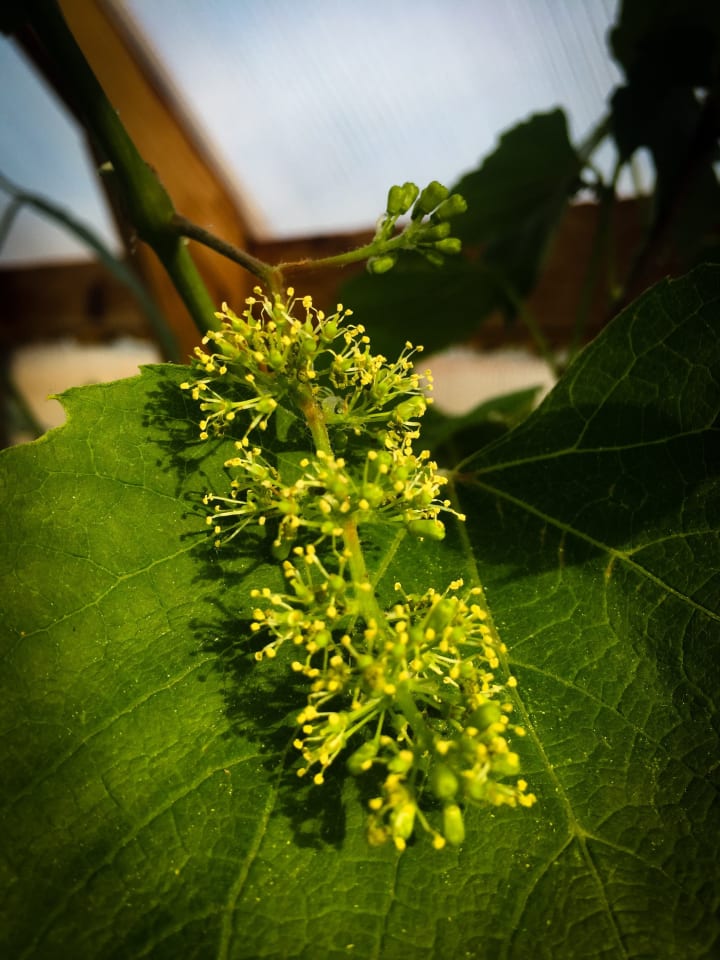
A grape flower cluster
The next question I had was, would my grape flowers pollinate in my greenhouse without bees? I had no idea—it was all so new and experimental to me! I left the greenhouse door open some days, hoping bees would fly in... but I never saw any buzzing around. I really wanted grapes, so I ended up brushing the grape blooms lightly with my fingers, spreading out the pollen.
Well that seemed a bit dirty... but you do what you have to for the sake of putting food on the table, right? Hahaha... I digress with my own garden jokes.
In later research, I found out grape blossoms pollinate naturally in the air and wind as long as they have adequate sunlight. That's a key point for which I will refer back to later in this article.
Soon, the blossoms on my grape plants were growing into plump grape berries in really nice, big, green clusters. I also noticed my plants were taking on a lot of water. I had to water them every day, and they drank it all up each day from the bottom dish. My makeshift mini-trellis I made from PVC pipe and wires was holding up okay, although I could see it sagging a bit from the weight of the grapes.
And then I was waiting for the most exciting moment... the point in which my grapes would start changing color, called veraison. It's when all the sugars and that wonderful grape flavor take over, and you wait for the right moment to pick.
What Did I Make?
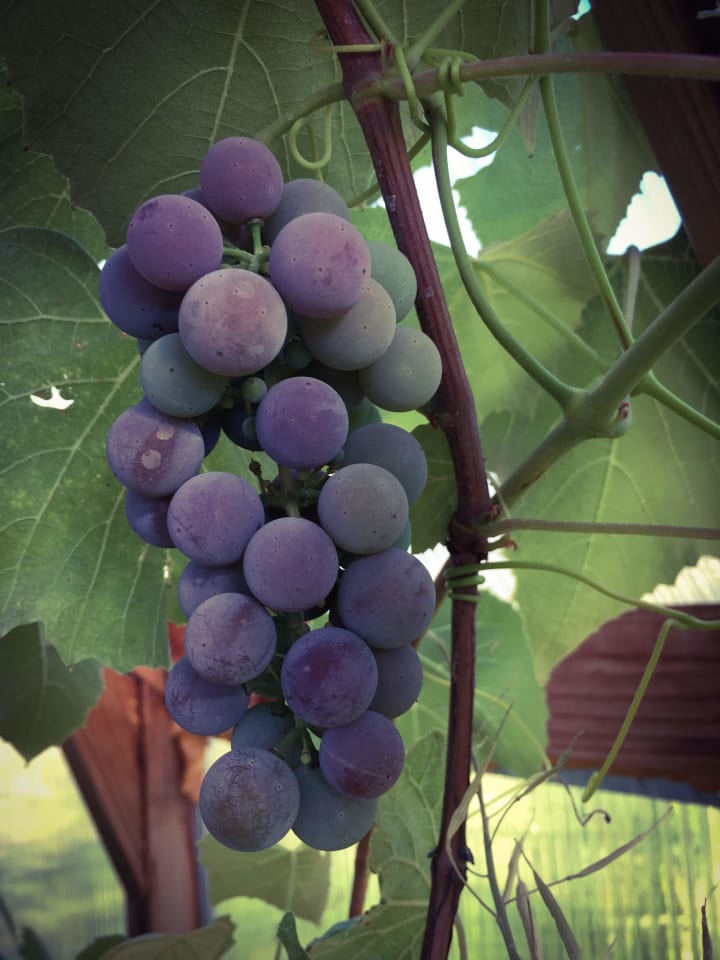
Veraison happening in these purple beauties!
In all, I got 21 bunches of Bluebell table grapes. I could have had more, but my second plant had sick roots and did not produce much. Also, its leaves were not as prolific as my big plant. But I was excited to get my first ever crop of delicious grapes!
So the next question I had to ask myself, what am I going to make with my wonderful grapes?
I could have eaten them all right there! They tasted just like grape jelly and burst in the mouth when eaten. But I knew why I bought them in the first place—I was going to make wine!
From Crabapples to Grapes
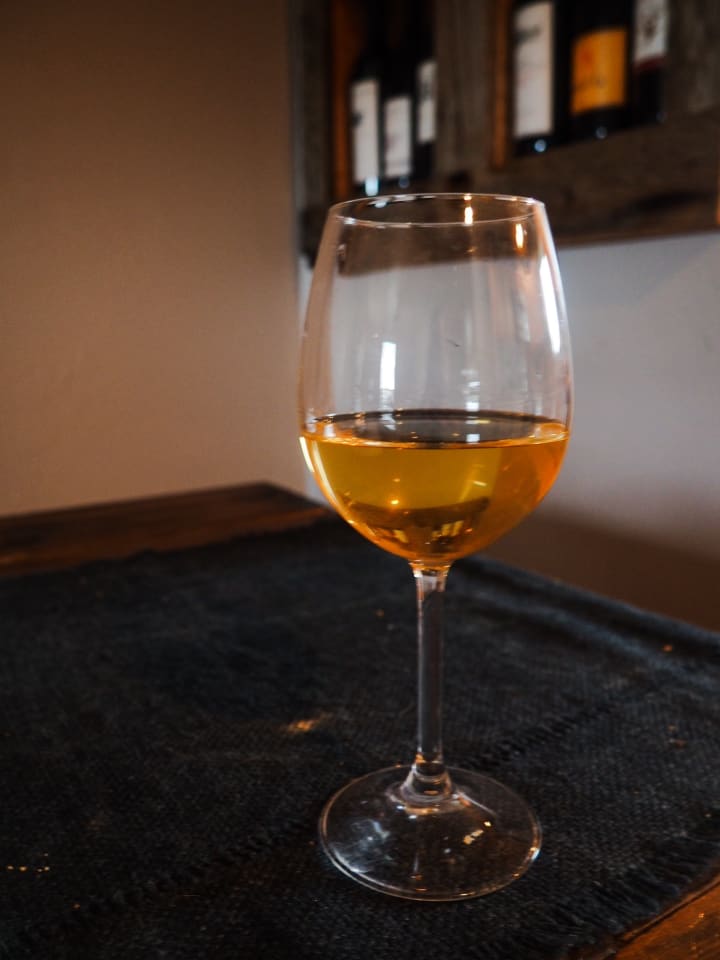
Homemade Crabapple wine
I've been experimenting with winemaking for quite a few years. I first got the idea of making wine from the crabapples growing on my parent's tree at the family homestead. I did some research, visited a local home brew shop, and got the supplies. I made my first batch of eight bottles and let it age for about a year. It turned out pretty good (at least, I thought so)!
I was so proud of my wine that I decided to look for a winemaking competition, and thus I submitted a bottle to the International Winemakers Competition that took place that year in Portland, Oregon. I even decided to go to Portland to be there for the awards ceremony. Did I win, you ask? Nope. Didn't even get a medal. But I got great notes from the tasters, and that was extremely valuable info. I learned my wine looked great, but it had an oxidized aftertaste caused from too much exposure to oxygen. Ouch. Good to know, and those tasters seemed to really know their stuff.
I continued to make wine from crabapples for a few years, learning as I went. I submitted another bottle to the competition, and I still didn't place. But I enjoyed my own wine, made from my own fruit. It was immensely satisfying. And that's the main reason why I bought those grapes in the first place. I told myself it was time to graduate to the real deal and make real wine from grapes.
Harvesting the First Batch
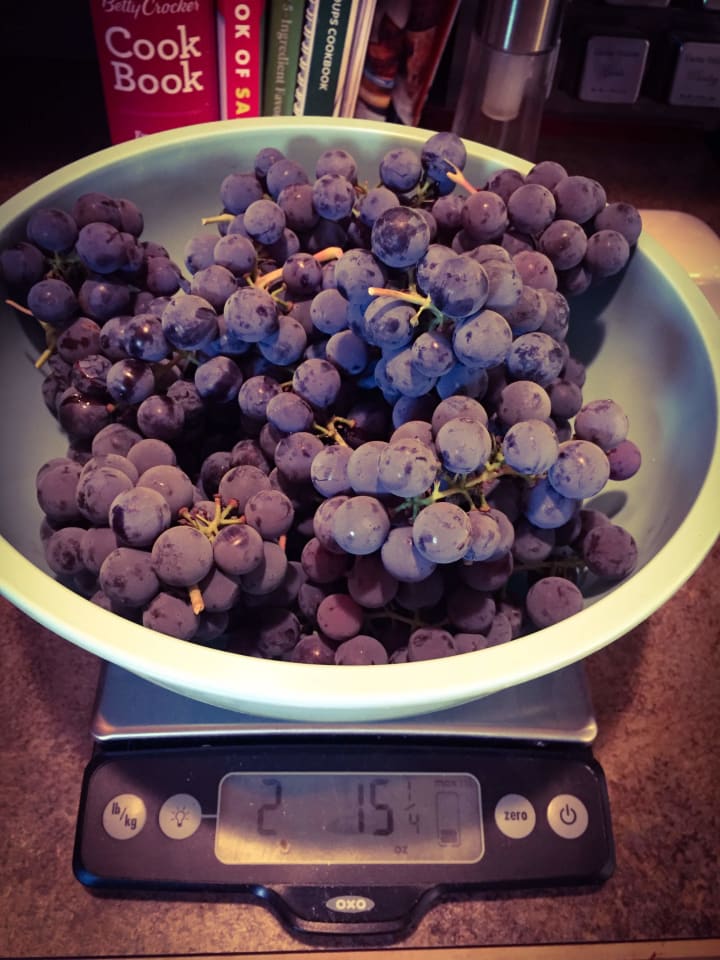
2 lbs 15 1/4 oz
When I picked all of my grapes, it was so fun to see them in a big bowl! And I really didn't have much... just two pounds, 15 1/4 oz. How much juice was I going to get?
Also, the specific grape I had was considered a table grape rather than a wine grape. That meant that most people would make juice, jelly or serve them on the table to eat. My inquisitive brain wondered why... and I found out that most wine grapes are more acidic than table grapes, which are sweeter. To make wine, higher acid is important for that nice rounded finish to a wine. But that didn't mean I couldn't make wine from MY grapes. Really, you can make wine out of anything you want (including dandelions, rose petals, fruit, or honey, which is mead). The bigger question was how much juice I would get from this batch.
I put my grapes into a cheesecloth and squeezed as hard as I could... and I only got about two cups of juice—hardly enough to make a full bottle of wine! But I did something I'm not really proud of as an amateur winemaker... I added water. I watered down the wine (confession time)! More jokes, sorry. I'm not proud of this, though, really. It's a no-no.
Well, I soaked the beautiful purple skins in the must and got a very nice, deep ruby color to my first ever watered-down homemade bottle of grape wine (cringe). Really pretty... but not much taste, I can hear the wine tasters say. Needless to say, I did not submit this bottle to the competition.
Winter Reading
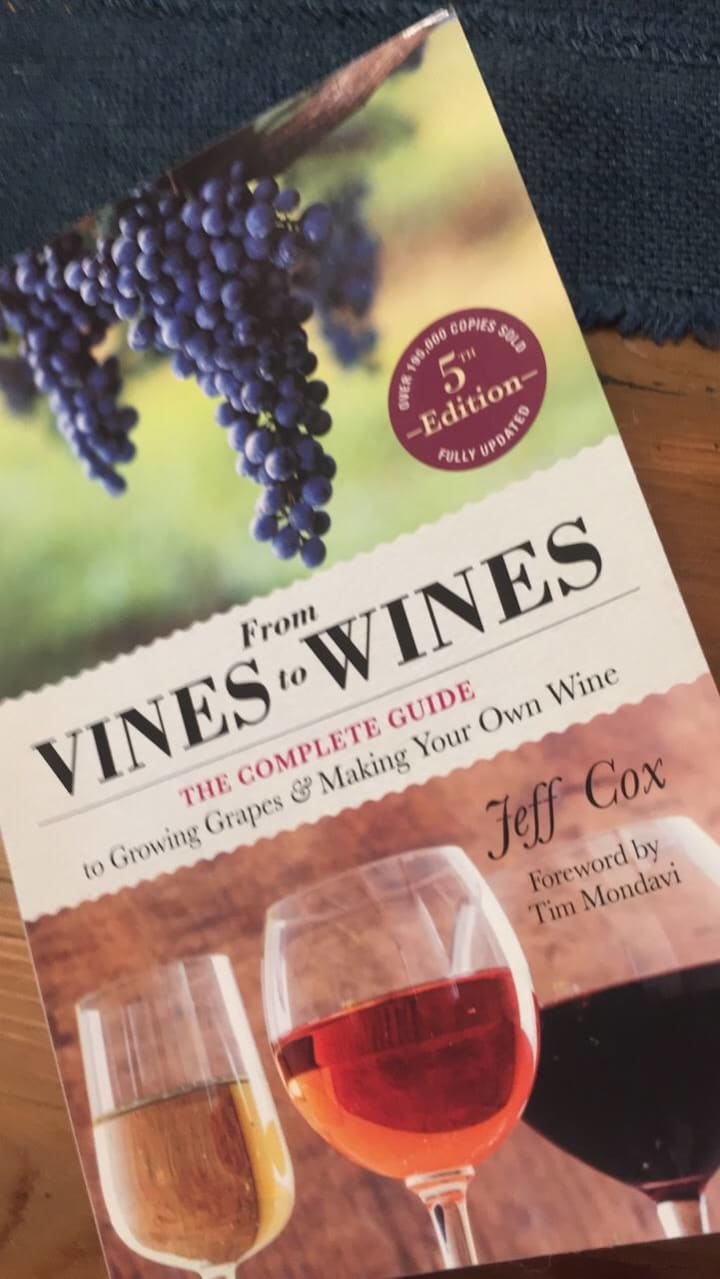
A great how-to book. Highly recommended!
When Autumn came, I took my grape plants outside the greenhouse to let them prepare for winter dormancy. The leaves fell, and I gently tied up the leftover woody vines and brought them inside.
During the long winter, I found one of the most excellent books I've ever purchased, From Vines to Wines: the Complete Guide by Jeff Cox. It has opened my eyes really wide to the art of viticulture, of growing grapevines and producing your own wine from them. It's basically a step-by-step blueprint of having your own vineyard, from selecting the grapes, planting them, building the right trellis, learning when to harvest, and turning those grapes into delicious wine.
That vision I had when I first bought my Bluebell grapes of an old world Italian villa surrounded by luscious grapevines and a rustic winery (basically my fantasy) came charging back to my psyche. But I had to find authentic wine grapes. Were there any that could grow in Montana?
I began to do some research online.
Montana is zone 3, and most wine grapes can't survive here. If I could figure out how to keep alive a Cabernet, Merlot, or a Pinot Gregio without moving someplace like California, I would. Maybe a Riesling would work, because Germany and Montana have similar climates, right? Probably not. But, I discovered something interesting... Minnesota developed their own French/American hybrids because they wanted to start vineyards and wineries in their cold northern climate.
Similar to Montana.
And guess what? My little Bluebell grapes were one of the first hybrids developed at the University of Minnesota. Cold-hardy to -30 degrees F, with vigorously growing vines that produce early. And they also developed wine grapes.
It wasn't long until I found a vineyard called Double A Vineyards out of New York that sold stock grape plants of Minnesota French/American hybrids. I browsed their online catalogue and found three varieties that piqued my interest: Frontenac, Frontenac Gris, and Itasca. Frontenac is a red, nearly black grape that makes a dry red wine with cherry aromas and other red fruit. Frontenac Gris is a "bud sport" of the same grape, but it lacks the dark skin color, and it makes a dry white or rose' wine with notes of peach, apricot, and tropical fruits. Finally, Itasca is a white grape producing a dry pale yellow to straw colored wine with notes of pear, melon and honey.
I decided to order two of each for a total of six wine grapevines. I admit I bought them based on their wine description! Combined with my Bluebell grapes, I would have eight grapevines. My own micro-vineyard! I was super excited.
On a side note: remember when I took my Bluebell grapes inside? Well, they started to bud out early. In February. I was elated, but also concerned. I let them grow indoors while the outdoors remained Arctic until about May. I just let my vines do their thing. When the blossoms formed, I tried to pollinate them... but they just dried up and fell off. All of them fell off! I was so disappointed.
Why did they do that? I found out that they probably weren't getting enough sunlight in my north facing window. Grapes like sunlight. Ihad to remember that as I was planting my brand new vineyard.
My New Vineyard
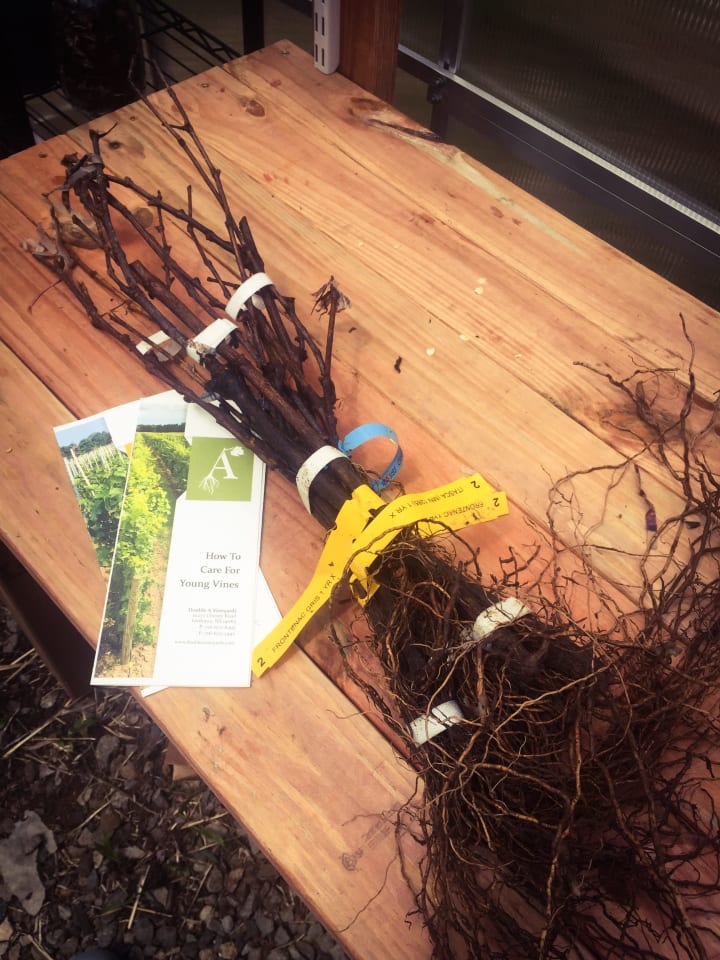
My little baby wine grapes ready for planting!
I received my new grapevines at the end of May this year via FedEx, and the roots were still cold! They were dormant, 1-year stock vines, and they were ready to get in the ground. I wanted to plant them right away!
Using the advice from my book, I planted them in rows seven to eight feet apart in a bright sunny place in the garden. This first year, I am focusing on growing them straight up a bamboo pole, making a sturdy upright sprig for building a trunk. I'm planning to build the trellis this Fall so they will be ready to branch out with their vines next spring into cordons, which are the T-shaped vines you see at the west coast vineyards. I cannot wait to see them fully grown!
Will They Survive?
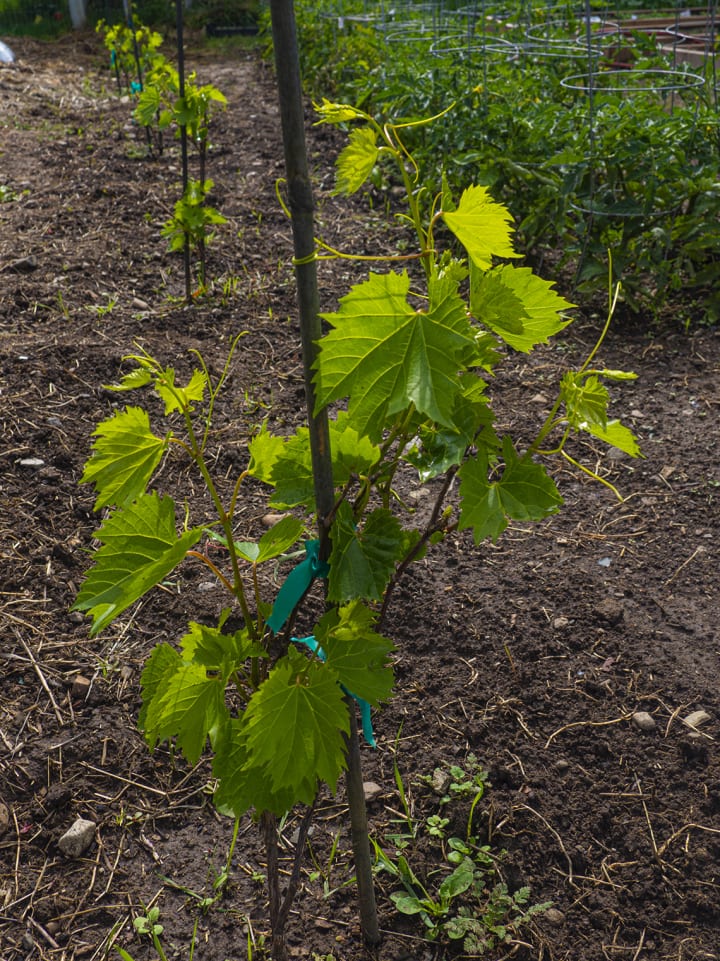
Happy little vines
So far, my little vineyard is doing well. The focus right now is root growth rather than fruit, because I want them to survive our Montana winters! I'm watching them reach up and stretch to the tallest part of the six-foot bamboo poles, and later this season when they go dormant, I will build the two wire trellis so they will be ready for the spring. When I first start to see buds growing next year, I will trim them down to one trunk with four to five buds near the top for growing the cordons. I might get some fruit next year (I certainly hope so!), but that still won't be the primary focus until the third summer. By then, I should have a vigorous, well-trained vine with lots of fruit that I can hopefully make five or six gallons of nectar of the gods—otherwise known as vino. :D
But... I will still need to wait at least a year after that to let the vino age to perfection... sigh.
Patience, Padawan. That is the name of the game when it comes to vineyards and making wine, I am learning. But I get so much joy from growing grapes, I'm actually cheering for them. I want them to be happy here in Montana—their new home. I can't wait to see what they do!
If you like what you are reading, feel free to send me some tip love with the button on this page. I greatly appreciate it, and I hope the readers get to experience the joys of growing grapes. Until next time!
About the Creator
Clayton Oberquell
I love to explore our National Parks, wilderness and public lands with my Olympus camera. I live in Montana near Yellowstone NP, and I enjoy fly fishing, backpacking, and wandering. I write poetry, sing, and play piano for a living.






Comments
There are no comments for this story
Be the first to respond and start the conversation.